China’s first drone to be powered by an engine that uses explosions to propel aircraft to unparalleled speeds has made a successful maiden flight at an undisclosed airfield in Gansu province.
The FB-1 Rotating Detonation Engine (FB-1 RDE) was developed jointly by Chongqing University Industrial Technology Research Institute and Thrust-to-Weight Ratio Engine (TWR), a Shenzhen-based private company.
Images circulating online show the engine ignited and tested during the taxiing phase of the drone, which is about five metres (16ft) long. It is unclear whether the engine continued to operate during the flight.
Do you have questions about the biggest topics and trends from around the world? Get the answers with SCMP Knowledge, our new platform of curated content with explainers, FAQs, analyses and infographics brought to you by our award-winning team.
According to a Chongqing Morning News report on Wednesday, the engine ignition experiment was also the drone’s first flight. The craft was developed by the university, with participation by TWR, it said.
A range of ground tests were previously carried out on the RDE engine before it was mounted to the drone for its maiden flight, the report said.
“It uses kerosene fuel and features rapid ignition, and could power an aircraft from zero-speed to several times the speed of sound,” it said.

Traditional turbojet engines use fan blades to draw in air, creating significant drag at speeds above Mach 3. The ramjet engine can take the aircraft beyond this limit by using its shape to compress incoming air, but fails to offer better combustion efficiency.
The RDE could become an optimal solution. It employs a ring-shaped combustion chamber, where controlled explosions generate shock waves that induce complete combustion of fuel and air.
The explosion is much more efficient than turbojet and ramjet engines, giving RDEs the potential to revolutionise supersonic flight while consuming less fuel. And, unlike scramjet engines – which generally require speeds above Mach 4 to initiate – the RDE can start at zero and are easier to maintain.
The technology is not without its challenges. The internal walls of the engine must withstand the impact of constant shock waves, demanding high standards in structural integrity and material strength.
The successful test could have a far-reaching impact on applications from commercial space rockets and high-speed drones to military aircraft and guided missiles.
“This recent development marks a crucial step in TWR’s integrated strategy for advancing detonation engine and detonation-powered flight technologies,” said TWR, in a WeChat post on Wednesday announcing the test flight.
According to a TWR statement in March, its RDE has already achieved a thrust of 1,000 Newtons, and products are expected to be launched within two years.
More from South China Morning Post:
- China launches ‘Kuafu’ nuclear fusion research facility, named after mythical giant, in quest to build ‘artificial sun’
- Rocket failure marks rare setback for China’s satellite network plans
- Chinese scientists look to 6G to hunt submarines, testing device small enough to fit on drone
For the latest news from the South China Morning Post download our mobile app. Copyright 2023.





